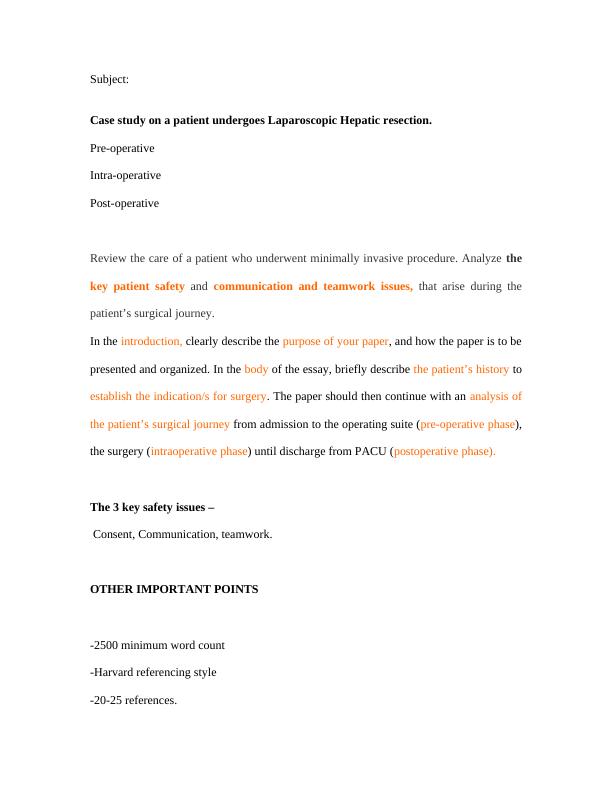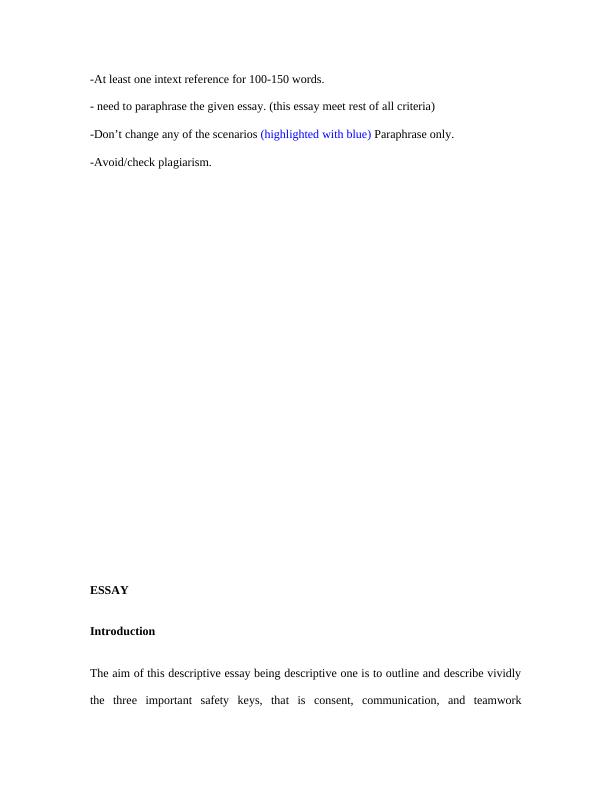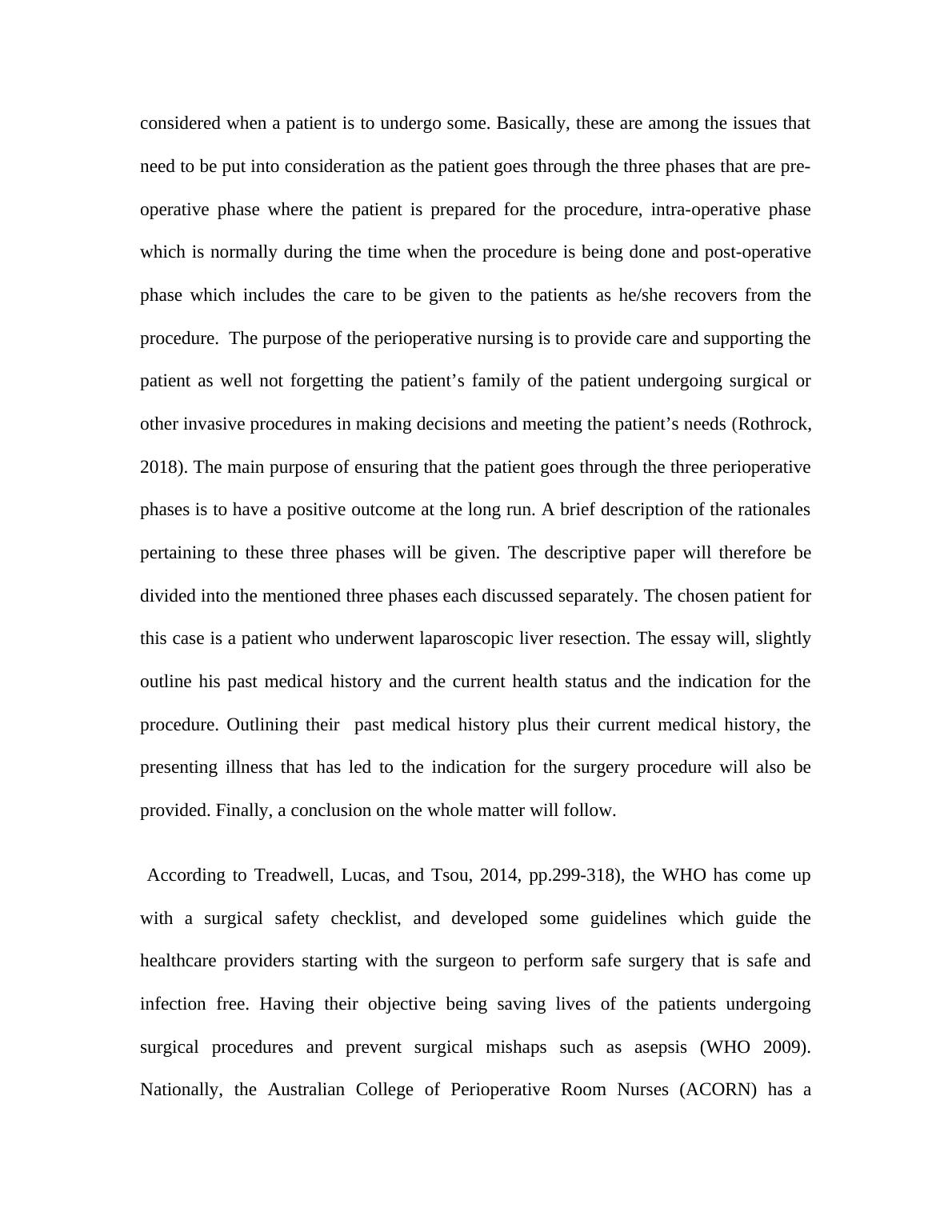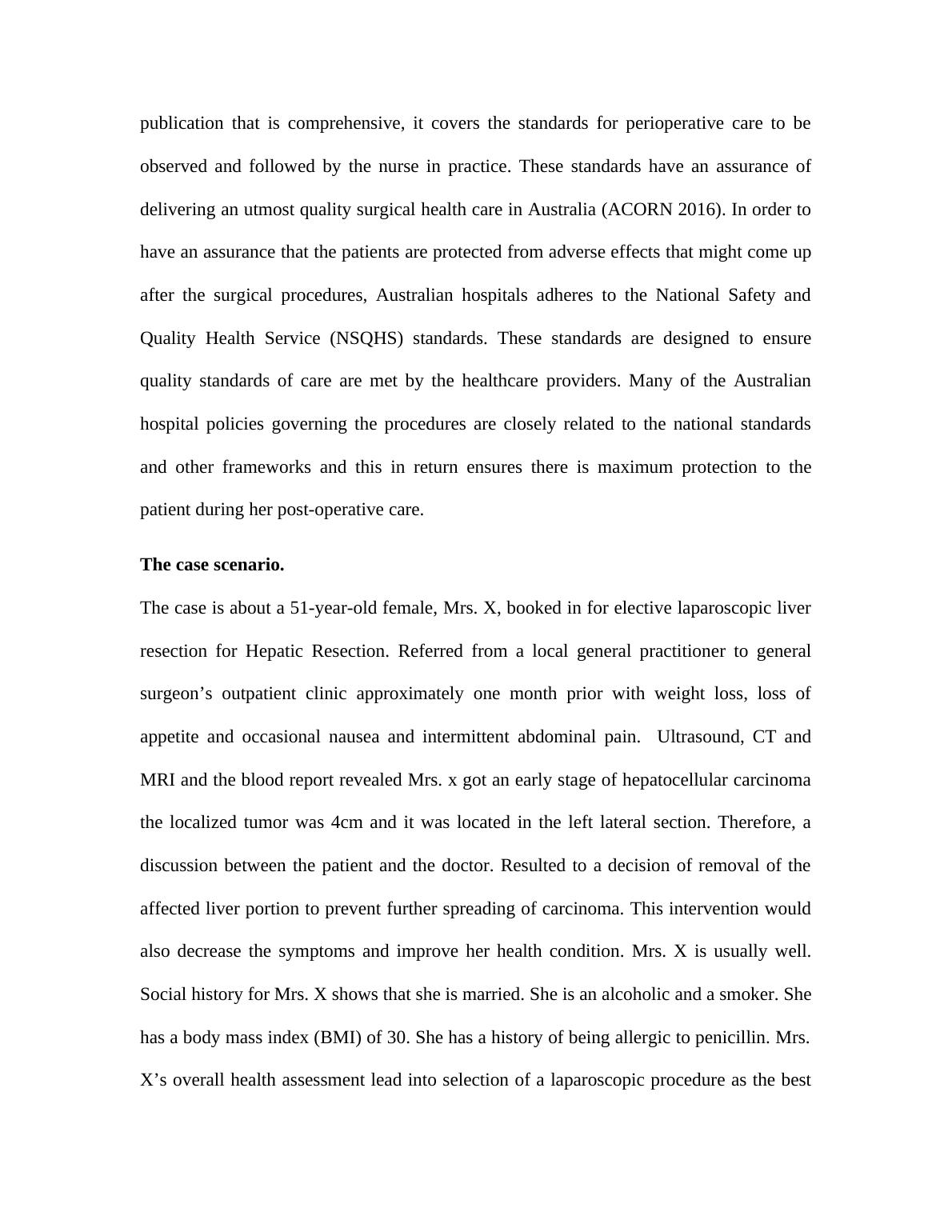Case Study on Laparoscopic Hepatic Resection
Added on 2023-03-17
15 Pages3920 Words87 Views
Subject:
Case study on a patient undergoes Laparoscopic Hepatic resection.
Pre-operative
Intra-operative
Post-operative
Review the care of a patient who underwent minimally invasive procedure. Analyze the
key patient safety and communication and teamwork issues, that arise during the
patient’s surgical journey.
In the introduction, clearly describe the purpose of your paper, and how the paper is to be
presented and organized. In the body of the essay, briefly describe the patient’s history to
establish the indication/s for surgery. The paper should then continue with an analysis of
the patient’s surgical journey from admission to the operating suite (pre-operative phase),
the surgery (intraoperative phase) until discharge from PACU (postoperative phase).
The 3 key safety issues –
Consent, Communication, teamwork.
OTHER IMPORTANT POINTS
-2500 minimum word count
-Harvard referencing style
-20-25 references.
Case study on a patient undergoes Laparoscopic Hepatic resection.
Pre-operative
Intra-operative
Post-operative
Review the care of a patient who underwent minimally invasive procedure. Analyze the
key patient safety and communication and teamwork issues, that arise during the
patient’s surgical journey.
In the introduction, clearly describe the purpose of your paper, and how the paper is to be
presented and organized. In the body of the essay, briefly describe the patient’s history to
establish the indication/s for surgery. The paper should then continue with an analysis of
the patient’s surgical journey from admission to the operating suite (pre-operative phase),
the surgery (intraoperative phase) until discharge from PACU (postoperative phase).
The 3 key safety issues –
Consent, Communication, teamwork.
OTHER IMPORTANT POINTS
-2500 minimum word count
-Harvard referencing style
-20-25 references.

-At least one intext reference for 100-150 words.
- need to paraphrase the given essay. (this essay meet rest of all criteria)
-Don’t change any of the scenarios (highlighted with blue) Paraphrase only.
-Avoid/check plagiarism.
ESSAY
Introduction
The aim of this descriptive essay being descriptive one is to outline and describe vividly
the three important safety keys, that is consent, communication, and teamwork
- need to paraphrase the given essay. (this essay meet rest of all criteria)
-Don’t change any of the scenarios (highlighted with blue) Paraphrase only.
-Avoid/check plagiarism.
ESSAY
Introduction
The aim of this descriptive essay being descriptive one is to outline and describe vividly
the three important safety keys, that is consent, communication, and teamwork

considered when a patient is to undergo some. Basically, these are among the issues that
need to be put into consideration as the patient goes through the three phases that are pre-
operative phase where the patient is prepared for the procedure, intra-operative phase
which is normally during the time when the procedure is being done and post-operative
phase which includes the care to be given to the patients as he/she recovers from the
procedure. The purpose of the perioperative nursing is to provide care and supporting the
patient as well not forgetting the patient’s family of the patient undergoing surgical or
other invasive procedures in making decisions and meeting the patient’s needs (Rothrock,
2018). The main purpose of ensuring that the patient goes through the three perioperative
phases is to have a positive outcome at the long run. A brief description of the rationales
pertaining to these three phases will be given. The descriptive paper will therefore be
divided into the mentioned three phases each discussed separately. The chosen patient for
this case is a patient who underwent laparoscopic liver resection. The essay will, slightly
outline his past medical history and the current health status and the indication for the
procedure. Outlining their past medical history plus their current medical history, the
presenting illness that has led to the indication for the surgery procedure will also be
provided. Finally, a conclusion on the whole matter will follow.
According to Treadwell, Lucas, and Tsou, 2014, pp.299-318), the WHO has come up
with a surgical safety checklist, and developed some guidelines which guide the
healthcare providers starting with the surgeon to perform safe surgery that is safe and
infection free. Having their objective being saving lives of the patients undergoing
surgical procedures and prevent surgical mishaps such as asepsis (WHO 2009).
Nationally, the Australian College of Perioperative Room Nurses (ACORN) has a
need to be put into consideration as the patient goes through the three phases that are pre-
operative phase where the patient is prepared for the procedure, intra-operative phase
which is normally during the time when the procedure is being done and post-operative
phase which includes the care to be given to the patients as he/she recovers from the
procedure. The purpose of the perioperative nursing is to provide care and supporting the
patient as well not forgetting the patient’s family of the patient undergoing surgical or
other invasive procedures in making decisions and meeting the patient’s needs (Rothrock,
2018). The main purpose of ensuring that the patient goes through the three perioperative
phases is to have a positive outcome at the long run. A brief description of the rationales
pertaining to these three phases will be given. The descriptive paper will therefore be
divided into the mentioned three phases each discussed separately. The chosen patient for
this case is a patient who underwent laparoscopic liver resection. The essay will, slightly
outline his past medical history and the current health status and the indication for the
procedure. Outlining their past medical history plus their current medical history, the
presenting illness that has led to the indication for the surgery procedure will also be
provided. Finally, a conclusion on the whole matter will follow.
According to Treadwell, Lucas, and Tsou, 2014, pp.299-318), the WHO has come up
with a surgical safety checklist, and developed some guidelines which guide the
healthcare providers starting with the surgeon to perform safe surgery that is safe and
infection free. Having their objective being saving lives of the patients undergoing
surgical procedures and prevent surgical mishaps such as asepsis (WHO 2009).
Nationally, the Australian College of Perioperative Room Nurses (ACORN) has a

publication that is comprehensive, it covers the standards for perioperative care to be
observed and followed by the nurse in practice. These standards have an assurance of
delivering an utmost quality surgical health care in Australia (ACORN 2016). In order to
have an assurance that the patients are protected from adverse effects that might come up
after the surgical procedures, Australian hospitals adheres to the National Safety and
Quality Health Service (NSQHS) standards. These standards are designed to ensure
quality standards of care are met by the healthcare providers. Many of the Australian
hospital policies governing the procedures are closely related to the national standards
and other frameworks and this in return ensures there is maximum protection to the
patient during her post-operative care.
The case scenario.
The case is about a 51-year-old female, Mrs. X, booked in for elective laparoscopic liver
resection for Hepatic Resection. Referred from a local general practitioner to general
surgeon’s outpatient clinic approximately one month prior with weight loss, loss of
appetite and occasional nausea and intermittent abdominal pain. Ultrasound, CT and
MRI and the blood report revealed Mrs. x got an early stage of hepatocellular carcinoma
the localized tumor was 4cm and it was located in the left lateral section. Therefore, a
discussion between the patient and the doctor. Resulted to a decision of removal of the
affected liver portion to prevent further spreading of carcinoma. This intervention would
also decrease the symptoms and improve her health condition. Mrs. X is usually well.
Social history for Mrs. X shows that she is married. She is an alcoholic and a smoker. She
has a body mass index (BMI) of 30. She has a history of being allergic to penicillin. Mrs.
X’s overall health assessment lead into selection of a laparoscopic procedure as the best
observed and followed by the nurse in practice. These standards have an assurance of
delivering an utmost quality surgical health care in Australia (ACORN 2016). In order to
have an assurance that the patients are protected from adverse effects that might come up
after the surgical procedures, Australian hospitals adheres to the National Safety and
Quality Health Service (NSQHS) standards. These standards are designed to ensure
quality standards of care are met by the healthcare providers. Many of the Australian
hospital policies governing the procedures are closely related to the national standards
and other frameworks and this in return ensures there is maximum protection to the
patient during her post-operative care.
The case scenario.
The case is about a 51-year-old female, Mrs. X, booked in for elective laparoscopic liver
resection for Hepatic Resection. Referred from a local general practitioner to general
surgeon’s outpatient clinic approximately one month prior with weight loss, loss of
appetite and occasional nausea and intermittent abdominal pain. Ultrasound, CT and
MRI and the blood report revealed Mrs. x got an early stage of hepatocellular carcinoma
the localized tumor was 4cm and it was located in the left lateral section. Therefore, a
discussion between the patient and the doctor. Resulted to a decision of removal of the
affected liver portion to prevent further spreading of carcinoma. This intervention would
also decrease the symptoms and improve her health condition. Mrs. X is usually well.
Social history for Mrs. X shows that she is married. She is an alcoholic and a smoker. She
has a body mass index (BMI) of 30. She has a history of being allergic to penicillin. Mrs.
X’s overall health assessment lead into selection of a laparoscopic procedure as the best

End of preview
Want to access all the pages? Upload your documents or become a member.
Related Documents
Perioperative Care Case Studylg...
|13
|3886
|226
Nursing Assignment: Patient Undergoing Non-Cardiac Surgery after Coronary Stent Implantationlg...
|11
|2957
|53
